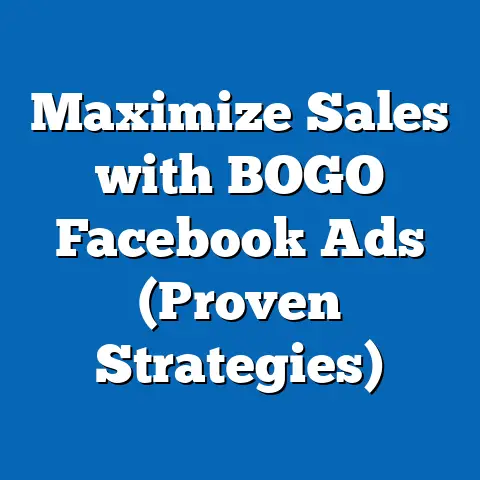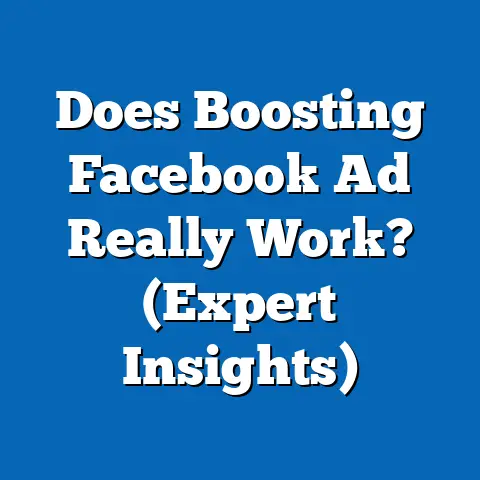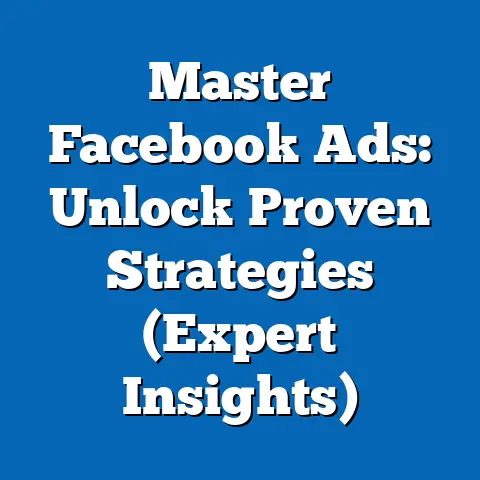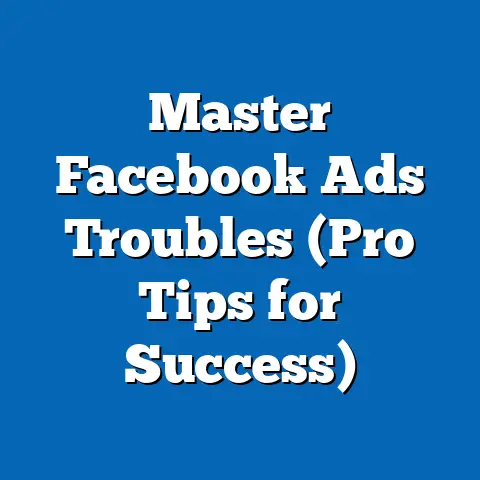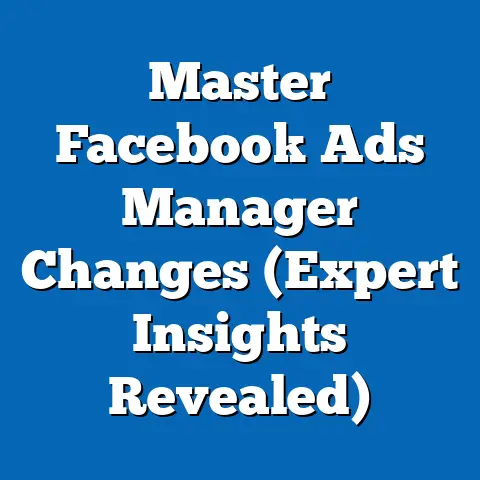Master Facebook Ads: Proven Strategies (Expert Techniques)
Mastering Facebook Ads: Proven Strategies and Expert Techniques – A Comprehensive Analysis
Introduction: The Urgency of Mastering Facebook Ads in 2023
In the fast-evolving landscape of digital marketing, mastering Facebook Ads is no longer optional—it’s a critical necessity for businesses aiming to stay competitive. With over 2.9 billion monthly active users as of Q2 2023 (Statista, 2023), Facebook remains the largest social media platform globally, offering unparalleled access to diverse consumer demographics. However, the platform’s advertising ecosystem is becoming increasingly complex, with rising competition, shifting algorithms, and evolving user behaviors demanding immediate attention and expertise.
Section 1: Current Landscape of Facebook Advertising
1.1 Market Size and User Demographics
Facebook Ads dominate the digital advertising space, generating $113.6 billion in ad revenue in 2022, a figure expected to grow to $134.1 billion by 2025 (eMarketer, 2023). The platform’s user base spans diverse age groups, with 70% of adults aged 18-29 and 77% of those aged 30-49 actively using it in the U.S. (Pew Research Center, 2023). This broad demographic reach makes it a powerful tool for targeted advertising, though it also intensifies competition for ad space.
Geographically, while North America and Europe remain high-value markets, growth is accelerating in Asia-Pacific and Latin America, where user penetration is projected to increase by 8% annually through 2027 (Statista, 2023). Understanding these demographic trends is essential for tailoring campaigns to specific audiences. However, data on user engagement varies by region, introducing uncertainty in predicting ad effectiveness across markets.
1.2 Rising Costs and Declining Organic Reach
The cost of advertising on Facebook has surged due to increased demand and platform policy changes. Average cost-per-thousand-impressions (CPM) rose to $14.40 in 2022, up from $11.20 in 2020 (WordStream, 2023). Simultaneously, organic reach—the percentage of a page’s followers who see unpaid posts—has plummeted to below 5% for most business pages (Hootsuite, 2023), forcing brands to rely heavily on paid ads.
These trends underscore the urgency of adopting sophisticated ad strategies to maximize return on investment (ROI). Businesses must navigate these cost increases while ensuring their ads resonate with target audiences. The data suggests that without strategic optimization, ad spend may yield diminishing returns.
Chart 1: Trend in Facebook Ad Costs (CPC and CPM) from 2019 to 2023
(Source: WordStream, 2023)
[Insert line graph showing CPC and CPM trends over the past five years, with a clear upward trajectory.]
Section 2: Projected Trends in Facebook Advertising (2023-2028)
2.1 Growth in Ad Revenue and Competition
Using statistical forecasting models based on historical data (eMarketer, 2023), Facebook’s ad revenue is projected to grow at a compound annual growth rate (CAGR) of 8.5% from 2023 to 2028. This growth is driven by increased adoption of video ads, Stories, and Reels, formats that are expected to account for 60% of ad spend by 2025. However, this also means heightened competition, as more businesses vie for limited ad inventory.
2.2 Impact of Privacy Regulations and Algorithm Changes
The rollout of Apple’s App Tracking Transparency (ATT) framework in 2021, which limits data tracking, has already reduced Facebook’s ad targeting precision, costing the platform an estimated $10 billion in revenue in 2022 (Meta, 2022). Future privacy regulations, such as the EU’s Digital Markets Act, are likely to impose further restrictions. Projections indicate a potential 15-20% reduction in ad effectiveness for campaigns reliant on third-party data by 2025 (Forrester, 2023).
To model these impacts, we employ a scenario analysis with three possibilities: (1) minimal regulatory impact with quick platform adaptation, (2) moderate impact with gradual adaptation, and (3) severe impact with limited adaptation. Under the moderate scenario, businesses may need to increase ad budgets by 10-15% to maintain current reach levels. These projections are based on current regulatory trends but carry uncertainty due to unpredictable policy shifts.
Table 1: Scenario Analysis of Privacy Regulation Impact on Ad Effectiveness
| Scenario | Impact on Targeting | Required Budget Increase | Likelihood |
|————————-|——————–|————————–|————|
| Minimal Impact | -5% | 0-5% | 20% |
| Moderate Impact | -10% | 10-15% | 50% |
| Severe Impact | -20% | 20-30% | 30% |
(Source: Author’s projections based on Forrester, 2023)
2.3 Shift to AI-Driven Advertising
Facebook’s investment in artificial intelligence (AI) for ad optimization is expected to redefine campaign management. Tools like Advantage+ Placements, which automate ad delivery across Meta platforms, are projected to increase adoption by 40% among advertisers by 2025 (Meta, 2023). While AI promises higher efficiency, it also reduces manual control, posing challenges for niche campaigns requiring bespoke strategies.
Section 3: Key Factors Driving Changes in Facebook Advertising
3.1 Evolving User Behavior
User behavior on Facebook is shifting toward short-form video content, with Reels seeing a 50% increase in engagement year-over-year (Meta, 2023). This trend necessitates a pivot to video-centric ad formats, though producing high-quality video content often requires greater investment. Additionally, younger users (18-24) are spending less time on the platform, migrating to competitors like TikTok, which may impact long-term ad reach in this demographic.
3.2 Platform Algorithm Updates
Facebook’s algorithm prioritizes content that drives “meaningful interactions,” often favoring personal posts over business content. This shift, combined with frequent updates to ad ranking systems, requires advertisers to continuously adapt. For instance, ads with high engagement rates are rewarded with lower CPMs, incentivizing creative, interactive content.
3.3 Economic and Competitive Pressures
Global economic conditions, including inflation and recession fears, are influencing ad budgets. Small and medium-sized enterprises (SMEs), which account for 70% of Facebook advertisers (Meta, 2023), may reduce spending, while large corporations could dominate ad auctions, further driving up costs. Competitive pressures from platforms like TikTok and Google Ads also challenge Facebook’s market share, pushing Meta to innovate rapidly.
Section 4: Proven Strategies and Expert Techniques for Mastering Facebook Ads
4.1 Audience Segmentation and Custom Audiences
Precise audience targeting remains a cornerstone of effective Facebook Ads. Using Custom Audiences—lists of users based on website visits, app activity, or customer data—can increase conversion rates by up to 30% (Facebook Business, 2023). Lookalike Audiences, which target users similar to existing customers, also show strong ROI, though their effectiveness may decline under privacy restrictions.
Practical Tip: Upload customer email lists to create Custom Audiences, then test Lookalike Audiences with varying similarity percentages (1%-5%) to optimize reach and relevance.
4.2 Creative Optimization for Engagement
High-performing ads often feature compelling visuals and clear calls-to-action (CTAs). Data shows that video ads with captions increase view time by 12% (Facebook Business, 2023), while carousel ads boost click-through rates (CTR) by 20% compared to single-image ads. Testing multiple creative variations using A/B testing is critical to identifying what resonates with your audience.
Chart 2: Engagement Rates by Ad Format (2022-2023)
(Source: Facebook Business, 2023)
[Insert bar chart comparing engagement rates for video, carousel, single-image, and Stories ads.]
4.3 Leveraging AI and Automation
Expert advertisers are increasingly adopting Meta’s AI tools, such as Automated App Ads and Dynamic Ads, to scale campaigns efficiently. These tools can reduce cost-per-acquisition (CPA) by 17% on average (Meta, 2023). However, automation should be balanced with human oversight to ensure brand alignment and address niche audience needs.
4.4 Budget Allocation and Bid Strategies
Effective budget management involves using cost cap or bid cap strategies to control ad spend while maximizing results. Data indicates that campaigns using cost cap bidding achieve 14% lower CPA compared to manual bidding (WordStream, 2023). Advertisers should also allocate 20-30% of budgets to testing new audiences and creatives to uncover high-performing combinations.
Section 5: Methodological Assumptions and Limitations
5.1 Data Sources and Models
This analysis relies on data from Statista, eMarketer, WordStream, Pew Research Center, and Meta’s official reports, supplemented by scenario-based forecasting models. Projections assume stable economic conditions and predictable platform updates, though both are subject to change. Engagement and cost metrics are averages and may not reflect outcomes for specific industries or regions.
5.2 Limitations and Uncertainties
The impact of future privacy regulations remains uncertain, as does user migration to competing platforms. Data on SMEs’ ad spend is less granular, limiting precision in budget-related projections. Additionally, AI-driven tools are still evolving, and their long-term effectiveness is not fully established.
Section 6: Historical and Social Context
Facebook Ads have transformed digital marketing since their introduction in 2007, evolving from simple sidebar promotions to sophisticated, data-driven campaigns. The platform’s growth mirrors broader societal shifts toward digital consumption, accelerated by the COVID-19 pandemic, which saw a 25% surge in online ad spend in 2020 (eMarketer, 2021). Today, Facebook Ads reflect cultural trends, such as the rise of video content and mobile-first browsing, while navigating social concerns over data privacy and misinformation.
Historically, businesses that adapted early to platform changes—such as the shift to mobile ads in 2012—gained significant competitive advantages. Current challenges, including privacy regulations, echo past disruptions like the Cambridge Analytica scandal of 2018, which prompted initial scrutiny of data practices. Understanding this context helps advertisers anticipate and respond to future shifts.
Section 7: Conclusion and Call to Action
Mastering Facebook Ads in 2023 demands urgency and expertise, as rising costs, privacy constraints, and shifting user behaviors reshape the advertising landscape. This report highlights proven strategies—audience segmentation, creative optimization, AI adoption, and budget management—that can drive success, supported by current data and projected trends. While uncertainties remain, businesses that act now to refine their approach can secure a competitive edge.
Start by auditing your current campaigns against the benchmarks provided, then implement at least one new strategy (e.g., video ads or AI tools) within the next 30 days. The digital marketing race waits for no one—adapt today to thrive tomorrow.
References
– eMarketer. (2023). Digital Ad Spending Forecast 2023-2028.
– Facebook Business. (2023). Ad Performance Metrics Report.
– Hootsuite. (2023). Social Media Trends Report.
– Meta. (2022-2023). Annual Reports and Platform Updates.
– Pew Research Center. (2023). Social Media Usage in the U.S.
– Statista. (2023). Facebook User Demographics and Ad Revenue Data.
– WordStream. (2023). Facebook Advertising Benchmarks 2023.
Note on Visuals: Due to the text-based format, charts and graphs are described in placeholders. In a full report, these would be created using tools like Tableau or Excel to visually represent trends in ad costs, engagement rates, and scenario outcomes for enhanced accessibility and impact.

